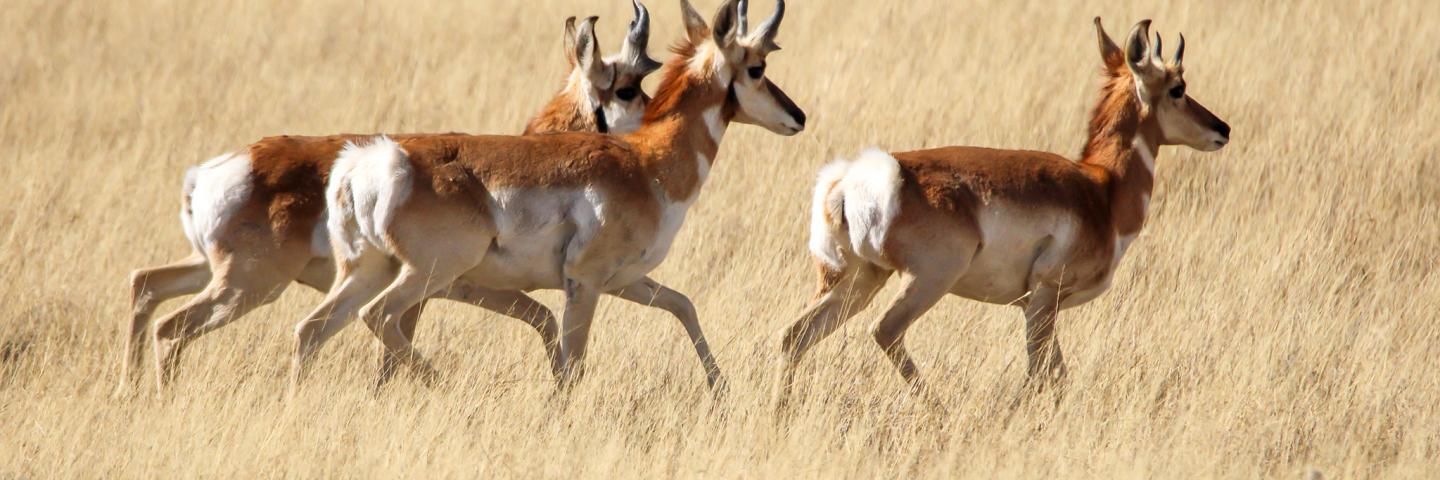
By Aedan Hannon
Casper Star-Tribune
Via- Wyoming News Exchange
CASPER — You could call big game migrations miracles and it wouldn’t be a stretch. One mule deer herd in western Wyoming migrates more than 150 miles each way from the Red Desert to the mountains around Hoback Basin near Jackson, navigating a myriad of human-made obstacles along the way.
In general, deer, pronghorn, elk and other big game species in Wyoming face a number of obstacles that complicate their historic migrations, from housing development and energy extraction to recreation and roadways.
Ungulates, or hoofed mammals, know no boundaries. While they migrate, they cross checkerboard landscapes, some private, others public.
When wildlife officials weigh conservation efforts, they must consider it all.
That reality led the U.S. Department of Agriculture to partner with Wyoming and launch the agency’s pilot Migratory Big Game Initiative in May 2022. The initiative, which is run by the USDA’s Natural Resources Conservation Service and Farm Service Agency alongside the Wyoming Game and Fish Department, works with farmers and ranchers to fund conservation on private working lands.
Now, the program is building on its success in Wyoming. The USDA announced Tuesday that it is expanding the Migratory Big Game Initiative to Montana and Idaho, allowing farmers and ranchers across the three states to access money to protect the migratory routes of big game populations.
“We’re pleased to announce the expansion of this initiative,” Jackie Byam, the NRCS’ Wyoming state conservationist, said in a statement. “It will help create new and enhanced opportunities through USDA’s conservation programs to keep working lands working and give farmers, ranchers, and forest landowners new opportunities to conserve wildlife and migration corridors.”
The initiative
The USDA launched the Wyoming pilot of its Migratory Big Game Initiative last year following meetings and listening sessions with state agencies, agricultural producers and other stakeholders that highlighted broad interest in protecting big game across the state through collaborative conservation efforts.
At its core, the initiative is composed of a series of voluntary incentive programs that pay and offer technical support to farmers and ranchers who want to take steps to improve their land for migrating big game. Agricultural producers apply to the programs based on their needs and then work with the Natural Resources Conservation Service and Farm Service Agency to plan conservation work on their lands, all the while ensuring that they can continue to grow crops and raise livestock.
“To date, most of our focus has been on removing or modifying fence that is not considered ‘wildlife friendly,’ treating invasive species that can degrade the forage value within migratory corridors, and permanently protecting important habitats through conservation easements,” Brian Jensen, the big game coordinator for the Natural Resources Conservation Service’s Wyoming state office, said in an email.
In its May 2022 announcement, the USDA initially committed $15 million in federal funding toward conservation easements and habitat improvement on top of other rental payments to farmers and ranchers who avoid working in sensitive areas, according to an agency press release.
That investment will now grow to $21.4 million for fiscal year 2024 as the initiative expands to Montana and Idaho.
In Wyoming, another $4 million will go toward conservation easements, while $5.2 million will fund land restoration and improvements across the state.
Beyond the scaling of the program to surrounding states, the influx of additional money will go toward streamlining the application process and expanding staffing to ultimately bring more agricultural producers into the fold.
Natural Resources Conservation Service leaders ultimately decided to grow the initiative after seeing its first-year success in Wyoming with landowner buy-in and growing awareness about the important role that migratory corridors play in big game conservation, Jensen said.
“The Wyoming pilot program had broad support from our State, Local, and National Partners that helped us craft and deliver it and ag producers have stepped up to show a willingness to complete projects that benefit big game and their operation,” he said.
Because the program is in its infancy, data showing the impact of the Migratory Big Game Initiative so far is limited. However, figures from the first year of the program highlight growing participation among farmers and ranchers, and in turn more working land improved for wildlife.
According to the USDA, the Natural Resources Conservation Service saw a 30% increase in the number of ranchers taking part in its grassland conservation program from 2022 to 2023. Participation in big game priority areas, which include parts of Carbon, Hot Springs, Lincoln, Park, Sublette, Sweetwater, Fremont and Teton counties, more than doubled, conserving roughly 37,000 acres of sensitive habitat in 2023.
In all, seven conservation easements and nearly 100 on-the-ground restoration projects conserved more than 315,000 of working lands across Wyoming, while nearly $1 million went to the University of Wyoming to support big game migration research and conservation work.
“It’s still largely too early to tell statistically, but the influx of funding has drastically increased the speed and scale at which we’re able to apply practices that have been shown to benefit big game,” Jensen said.
A collaborative approach
Migration corridors are critical for ensuring that Wyoming’s big game species thrive, allowing animals to find better forage and avoid the worst of seasons. They’re also at risk. And for deer, elk and other species, the splintering of these routes poses a significant threat.
“Research has shown that these amazing migration routes are passed down from one ungulate generation to the next and thus if they are severed for even a short period, they will likely be lost forever,” Jensen said.
It’s easy to turn to public lands, which account for roughly half of Wyoming, for a potential solution. But the state’s public land is not continuous, and migration corridors often wind across both public and private lands.
With conservation you can’t neglect private lands because they are essential for Wyoming’s big game, according to Jensen.
“Private land is often some of the most productive land that routinely contains important water and vegetation resources that bridge the gap between summer and winter range,” he said.
Much of that land is owned and stewarded by Wyoming’s farmers and ranchers, making them essential partners in any effort to conserve big game. Rather than passing along prescriptive mandates, the USDA’s Migratory Big Game Initiative aims to use voluntary programs and incentives to build collaboration between federal agencies and agricultural producers, ensuring that the livelihoods of farmers and ranchers do not come at the cost of conservation and are instead enhanced by it.
That approach has earned the acknowledgment of agricultural groups like the Wyoming Farm Bureau Federation.
“We do really appreciate the USDA’s efforts to involve farmers and ranchers in Wyoming and the West for these voluntary efforts,” said Kelly Carpenter, the Wyoming Farm Bureau Federation’s national affairs associate.
Instead of what Carpenter described as the federal government’s typical top-down approach, the Wyoming Farm Bureau Federation advocates for greater collaboration between farmers and ranchers and federal agencies when it comes to conservation.
“It’s just so important to have all stakeholders at the table,” Carpenter said. “We believe in that because it is an effort that requires everybody to do their part.”
While some may think that farming and ranching are at odds with conservation, that’s not the case, Carpenter added.
“At the end of the day [for] farmers and ranchers, when the wildlife flourishes, their place flourishes as well,” she said. “It’s definitely a symbiotic relationship.”
It’s a sentiment that Jensen also shares.
Farmers and ranchers often control important and imperiled habitat in the West, and they are key partners in the management of federal lands, he said.
“They are the day-to-day stewards of the land,” Jensen said. “And without their desire to maintain open space and our Western lifestyle, big game migrations and many other wildlife values could be lost forever.”




